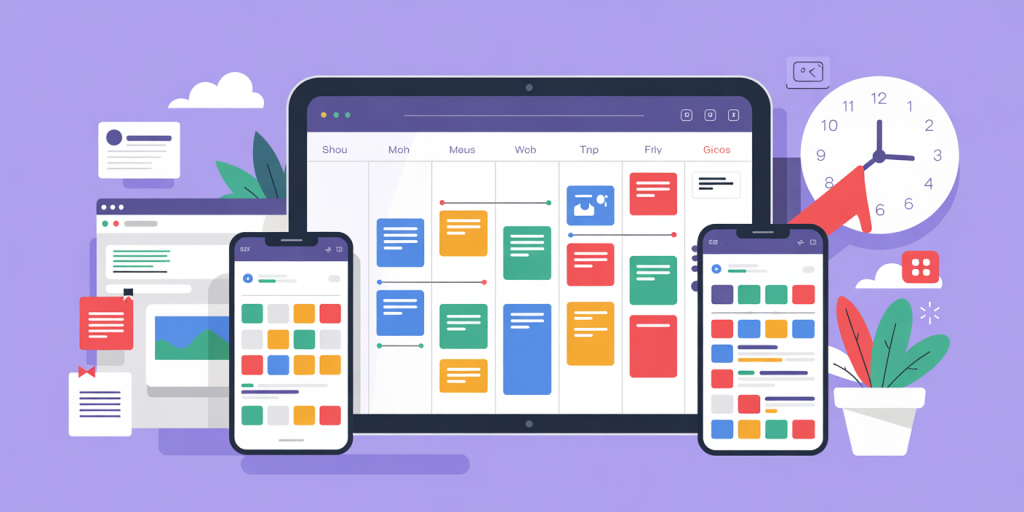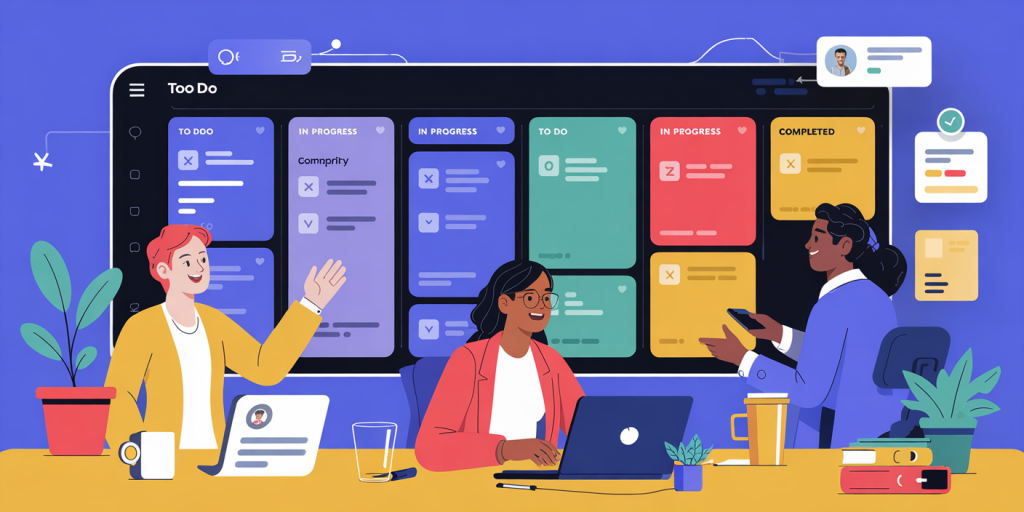Tools to Organize Your Routine and Boost Productivity
Anúncios
In today’s fast-paced world, managing a packed schedule and staying productive can be a daunting challenge. With endless tasks, deadlines, and distractions, maintaining an organized routine is essential for both personal and professional success. Fortunately, a wide array of tools designed to optimize time management and streamline workflows can help individuals navigate their daily responsibilities more effectively. Leveraging the right tools not only enhances productivity but also reduces stress and frees up time for more meaningful activities.
Studies show that disciplined routines improve productivity by up to 25%, as measured in various workplace experiments (Harvard Business Review, 2022). This highlights the importance of adopting structured systems supported by technology. Whether you’re a student, entrepreneur, or working professional, integrating the right organizational tools into your routine can dramatically enhance your ability to stay focused and accomplish your goals. This article explores some of the most effective tools available to help you manage your routine efficiently and boost your productivity.
Anúncios
Digital Calendars: The Backbone of Routine Management
Digital calendars have become foundational tools in organizing day-to-day activities, schedules, and deadlines. Platforms such as Google Calendar, Microsoft Outlook Calendar, and Apple Calendar offer intuitive interfaces that allow users to schedule appointments, set reminders, and share schedules with collaborators.
For instance, Google Calendar’s seamless integration with other Google Workspace apps enables effortless event creation and task management. Users can receive notifications across devices, thus reducing the likelihood of missed meetings or deadlines. According to a 2023 survey by Statista, 72% of professionals rely on digital calendars as their primary tool for time management.
Beyond basic scheduling, digital calendars allow color-coding of tasks, recurring event setup, and synchronized updates, which are vital for maintaining an organized routine. An example can be found in the corporate sector where managers coordinate team meetings across time zones, using calendar features to handle availability and resource allocation effectively. This results in smoother workflow coordination and improved team productivity.

Task Management Applications: Prioritizing and Tracking Progress
Task management apps are indispensable for breaking down work into actionable items, prioritizing tasks, and tracking progress throughout the day. Applications like Todoist, Asana, and Trello cater to individuals and teams seeking structured project and task control.
Todoist, for example, uses a simple interface combined with features like priority tags, due dates, and project compartments to keep users focused. A real-life application is a freelance graphic designer managing multiple client projects concurrently. Using Todoist allows them to divide projects into subtasks, allocate deadlines, and mark completed work, ensuring no deadline is missed.
Similarly, Trello utilizes a card and board system, appealing to those who prefer visual task management. Teams in digital agencies often adopt Trello to outline workflows in Kanban-style boards, moving tasks from ‘To Do’ to ‘In Progress’ to ‘Completed’. This visual flow drastically reduces confusion and streamlines communication.

In terms of effectiveness, a study from the Productivity Institute highlights that users of task management tools report a 30% increase in task completion rates compared to those relying solely on manual methods such as notebooks. Additionally, these apps often provide integrations with calendars and communication platforms, creating a comprehensive ecosystem for routine management.
| Feature | Todoist | Asana | Trello |
|---|---|---|---|
| Visual Task Boards | No | Yes | Yes |
| Priority Levels | Yes | Yes | Limited |
| Team Collaboration | Yes | Yes | Yes |
| Mobile App Support | Yes | Yes | Yes |
| Integration with Calendars | Yes | Yes | Yes |
Note-Taking and Information Organization Tools
Effectively capturing, organizing, and retrieving information is critical when managing a busy routine. Tools such as Evernote, Notion, and Microsoft OneNote help users consolidate notes, links, and files in one accessible place, providing significant productivity gains.
Evernote’s ability to sync notes across devices and categorize them with tags makes it ideal for students and knowledge workers alike. For example, a university student juggling multiple courses can create notebooks for each subject, organize lecture notes, and clip web articles for research. This ensures all related info is collected and easy to search, reducing time spent looking for materials.
Notion offers extensive customization with databases, wikis, and templates that adapt well to business settings. Startups frequently adopt Notion for maintaining operational documents, meeting notes, and project trackers in shared workspaces. This fosters transparency and collective knowledge management, which in turn accelerates decision-making processes.
Microsoft OneNote integrates deeply with the Microsoft Office ecosystem, making it a preferred choice in corporate environments. Its ability to draw, type, and insert multimedia allows versatile note-taking approaches, suited for creative and analytical workflows alike.
A 2023 market report from TechSmith revealed that individuals using organized digital note-taking systems reduce task recall time by 40%, underscoring the efficiency these tools bring to routine management.
Automation Tools: Minimizing Repetitive Workloads
Automation represents a powerful frontier in productivity enhancement, automating repetitive tasks to save time and reduce errors. Tools such as Zapier, IFTTT (If This Then That), and Microsoft Power Automate enable users to connect different apps and workflows for seamless automation.
Zapier, for example, allows the integration of over 5,000 apps where a trigger in one app causes an action in another. A typical use case is automatically saving email attachments from Gmail to a cloud storage service like Dropbox or Google Drive, removing manual download steps.
IFTTT offers similar functionality with a focus on simplifying personal and home automation. For instance, busy professionals might automate social media posting schedules, syncing calendars with smart home devices or creating reminders based on location.
Microsoft Power Automate integrates especially well with Microsoft 365 tools used in many enterprises. It automates document approvals, email workflows, and data gathering, drastically lowering the workload on administrative teams.
According to a 2022 Gartner report, companies that extensively adopt automation tools show a 20-30% increase in operational efficiency. By delegating mundane tasks to automated systems, individuals can focus more on high-value, strategic activities.
Focus and Time Tracking Tools: Enhancing Concentration and Efficiency
Maintaining focus amidst distractions is crucial for productivity. Time tracking and focus-enhancing tools such as RescueTime, Forest, and Pomodoro apps help users understand their habits and create productive work intervals.
RescueTime tracks computer and mobile device usage, providing reports that highlight time spent on productive versus distracting activities. With real data, users can adjust habits for better focus. For example, a software developer might realize that social media interruptions occur frequently during coding sessions; awareness leads to adopting strategies to reduce those distractions.
Forest gamifies focus by growing virtual trees during uninterrupted work periods, encouraging sustained concentration. Students and remote workers have reported improved study habits and less procrastination using such motivational tools.
The Pomodoro Technique, often implemented via apps like Focus Booster, divides work into 25-minute intervals with short breaks. This method promotes sustained attention and helps combat burnout. A survey by the American Psychological Association finds that regular breaks improve productivity by 15%, validating this technique.
| Tool | Primary Function | Key Benefit | Ideal For |
|---|---|---|---|
| RescueTime | Time tracking | Insight into productivity patterns | Professionals, students |
| Forest | Distraction minimization | Motivates focus through gamification | Remote workers, learners |
| Focus Booster | Pomodoro timer | Structured work-break intervals | Anyone needing focus |
Emerging Trends and Future Perspectives in Routine Management Tools
As technology evolves, future productivity tools promise even greater personalization and integration through artificial intelligence (AI) and machine learning (ML). AI-powered virtual assistants are becoming more capable of anticipating needs, automating complex scheduling conflicts, and providing contextual reminders.

For example, emerging tools like Microsoft 365’s Copilot utilize AI to summarize meetings, suggest task priorities, and even draft documents within workflows, reducing manual input and decision fatigue. Gartner predicts that by 2025, over 70% of knowledge workers will regularly use AI-driven productivity assistants, marking a transformative shift in routine management.
Additionally, increased adoption of wearable technology is enabling real-time monitoring of physical and mental states, offering data-driven recommendations to optimize work routines. Employers are experimenting with these insights to enhance workforce well-being and productivity simultaneously.
Cross-platform interoperability will further blur the boundaries between work and personal life management tools, creating seamless ecosystems that adapt fluidly to user contexts. Emphasis will also grow on privacy-centric designs, balancing productivity gains with data security.
In conclusion, the landscape of organizational tools is advancing rapidly to meet the complex demands of modern life. By adopting and adapting these tools thoughtfully, individuals and organizations can achieve significant productivity enhancements today while preparing for smarter, more integrated solutions in the near future.
